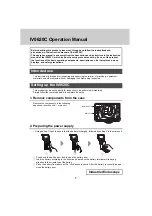
Model 6487 Reference Manual
Status Structure
10-5
Programming and reading registers
Programming enable registers
The only registers that can be programmed by the user are the enable registers. All other
registers in the status structure are read-only registers. The following explains how to
ascertain the parameter values for the various commands used to program enable registers.
The actual commands are covered later in this section (
through
A command to program an event enable register is sent with a parameter value that deter-
mines the desired state (0 or 1) of each bit in the appropriate register. An enable register
can be programmed using any of the following data formats for the parameter value:
binary, decimal, hexadecimal, or octal.
The bit positions of the register (
) indicate the binary parameter value. For
example, if you wish to sets bits B4, B3, and B1, the binary value would be 11010 (where
B4=1, B3=1, B1=1 and all other bits are 0). When you use one of the other formats, con-
vert the binary number to its decimal, hexadecimal, or octal equivalent:
Binary 11010 = Decimal 26 = Hexadecimal 1A = Octal 32
Note that
includes the decimal weight for each register bit. To set bits B4, B3,
and B1, the decimal parameter value would be the sum of the decimal weights for those
bits (16+8+2 = 26).
Figure 10-2
16-bit status register
The <NDN> (non-decimal numeric) parameter type is used to send non-decimal values.
These values require a header (#B, #H, or #Q) to identify the data format being sent. The
letter in the header can be upper or lower case. The <NRf> (numeric representation for-
B7
B15
B6
B5
B4
B3
B2
B1
B0
0/1
0/1
0/1
0/1
0/1
0/1
0/1
0/1
0/1
0/1
0/1
0/1
0/1
0/1
0/1
0/1
128
(2 )
7
32768
(2 )
15
64
(2 )
6
16384
(2 )
14
32
(2 )
5
8192
(2 )
13
16
(2 )
4
4096
(2 )
12
8
(2 )
3
2048
(2 )
11
4
(2 )
2
1024
(2 )
10
2
(2 )
1
512
(2 )
9
1
(2 )
0
256
(2 )
8
Bit Position
Bit Position
Binary Value
Binary Value
Decimal Weights
Decimal Weights
A. Bits 0 through 7
B. Bits 8 through 15
B14
B13
B12
B11
B10
B9
B8
















































